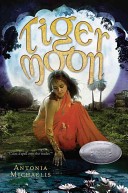 Tiger Moon
Tiger Moon
Written by Antonia Michaelis
Translated by Anthea Bell
Amulet, 2006/2008, 448 pp.
ISBN: 9780810944992
“Be quiet, be quiet, be quiet. You don’t understand at all. It doesn’t matter what’s true and what’s a fairy tale. That’s not what matters. The dividing lines aren’t as straight and simple as you think” (p. 299).
Told as a story within a story, Tiger Moon is a fairy tale about the power of naming and the potential of story to create reality. In both stories, the characters—human and divine—change their names and disguises as they journey through this incarnation and tell and retell stories that bring hope and ultimately freedom. When the main story opens, the stunningly beautiful Safia, whose name means “virtue,” has been sold and is to be wed to a rich merchant with seven other wives. On the night they consummate their marriage, Ahmed Mudhi will discover Safia is not a virgin; he will then have the right to kill her.
Safia calls herself Raka, which means “full moon.” While awaiting a certain death, Safia/Raka meets a supposed-eunuch servant named Lalit. In the tradition of the Persian storyteller Scheherazade, Safia/Raka nightly spins a fairy tale for Lalit about how a 16-year-old boy becomes a hero in order to rescue a princess from a forced marriage, a marriage that is scheduled to take place on the next full moon. According to Safia/Raka’s story, Krishna has drafted Farhad, a common thief, to rescue his daughter from the demon king. To accomplish this, Farhad joins forces with Nitish, a sacred white tiger whose name means “Lord of the Right Way,” and steals a precious jewel, the bloodstone, that Farhad will ultimately use to bargain for Krishna’s daughter.
Along the way, Farhad is pursued by a scoundrel who is out for the bloodstone and changes his nationality and name at each of their meetings. As he grows from a careless criminal to a hero on a mission of love, Farhad, too, changes his name to reflect each of the incarnations of Vishnu, one of the five primary forms of God in the Hindu tradition. In Tiger Moon, naming does matter; names bring with them powers and limitations. Like these characters, readers may come to believe that by changing how we name ourselves and others, we can change the course of our lives.
With memorable, poetic prose, Michaelis seamlessly weaves the two stories and brings them together for a satisfying, fairy tale ending. Hindu religion and culture are stitched into this adventure love story with well-drawn characters. Throughout the book, characters speak wisely about the power of stories to sustain people. As one character says, “Our fields are thirsty for rain, but our hearts are thirsty for stories. Come, sit by the fire and tell us yours” (p. 174).
Tiger Moon, originally written in German, was first published in Germany, and translated into English by Anthea Bell. Author Antonia Michaelis lived in southern India for one year during which time she taught English, arts, and acting. Readers who are unfamiliar with the Sanskrit epics may benefit from building their background knowledge in order to reach a deeper understanding of the relationships between the humans and the deities in this book. Tiger Moon earned a 2009 Batchelder Honor Award.
This young adult novel can be paired with others framed by traditional literature and enriched by the story within a story motif. In Where the Mountain Meets the Moon (2009), author and illustrator Grace Lin tells the story of a young girl who joins up with a flightless dragon on her quest to change her family’s fortune. Lin propels Minli’s journey forward by weaving in stories with Chinese folk and fairy tale motifs. In Here Lies Arthur (2008), Philip Reeve retells the Arthurian legends by changing the characters’ names and adding subplots that illuminate some of the mysteries in the legend of King Arthur. Reeve tells this story from the perspective of Myrddin’s (Merlin’s) slave girl/boy, Gwyna/Gwyn, who learns to tell all of Myrddin’s stories and in the end, creates stories of her own. All three authors, Michaelis, Lin, and Reeve, succeed in reframing traditional myths, tales, and legends into fresh stories that capture readers’ imaginations while they connect them with cultural and literary traditions.
Judi Moreillon, School of Library and Information Studies, Texas Woman’s University, Denton, TX
WOW Review, Volume II, Issue 4 by Worlds of Words is licensed under a Creative Commons Attribution-NonCommercial-ShareAlike 4.0 International License. Based on work at https://wowlit.org/on-line-publications/review/ii-4/

I like this story so much Nasreen’s.